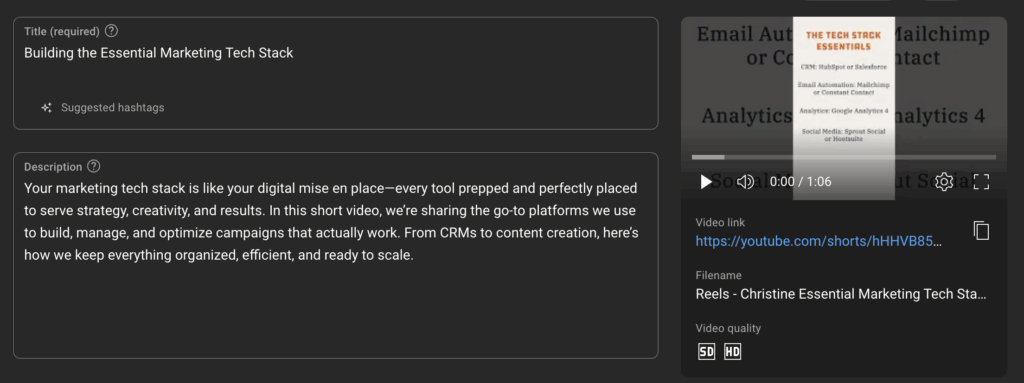Some people read. Some watch. Google does neither. It scans.
That’s why video SEO needs to work for humans and the machines indexing them.
The digital world is going video-first, and if your content strategy is still stuck in the blog boom of 2011, you’re missing out on eyeballs, clicks, and ranking opportunities. Search engines (read: Google, Bing… and dare we say, ChatGPT since it scans Google search engines) are obsessed with video, and with the rise of TikTok, YouTube Shorts, Reels, and AI-powered search previews, this obsession is only getting hotter.
We’ve seen that our clients who invested in video-first SEO don’t just get more views, they get more of the right views. These optimized videos show up where your audience is already searching, equalling higher-quality traffic to your site, stronger engagement with your message, and better outcomes for your content. Talk about meeting a customer where they are!
For our agency and our clients, this isn’t about chasing trends. It’s the difference between being discoverable and being overlooked. The businesses that adapt today are the ones that will lead the conversation tomorrow. Here’s how to ride the wave without wiping out.
What Is Video SEO? (And Why Should You Care?)
Video SEO is exactly what it sounds like: optimizing your video content so that it actually shows up in search results.
Done right, it helps you:
- Get more views
- Grow your subscriber count
- Send traffic to your site
- Win the war for attention spans shorter than a fruit fly’s memory
Think of it like blogging but louder, faster, and way more clickable.
Start with the Basics: Title, Description, and Keywords
Your video needs a great title and description. Not “kinda cute,” not “whatever the file was named”.
This is your hook. This is your elevator pitch. This is the make-or-break moment where someone decides to click your video… or your competitor’s.
Here’s how to stand out:
- Do your keyword research. Use tools like Semrush, Ahrefs, or even YouTube’s autocomplete bar.
- Keep titles under 60 characters. Make them punchy and clear.
- Include a strong, benefit-focused description. Drop that primary keyword in there naturally.
Bonus points if your video also matches the searcher’s intent. (i.e., don’t call it “How to Bake a Cake” and then spend 5 minutes talking about flour shortages.)

Give Search Engines What They Want: Text
We hate to break it to you, but Google still can’t “watch” your video. If you want to rank, you have to give the algorithm some text to chew on.
That means:
- Including a full transcript of your video
- Embedding text summaries or related blog content on the page
- Using captioning for accessibility and clarity
This doesn’t just help SEO. It helps real people, too. Like that silent scroller in a coffee shop who forgot their AirPods.

Why We Host Videos on YouTube (and You Should Too)
We get it. You want your traffic. You want to host videos directly on your site. But here’s the deal: YouTube is owned by Google.
That’s like sending your resume to HR and texting the hiring manager directly. You get seen faster. Plus, YouTube is a search engine in its own right—the second largest after Google itself. Hosting there = more discoverability. Just make sure you embed it on your site, too. That way, you get the best of both worlds: search traffic + web traffic.
Plus, if you’re investing in Google Ads, hosting your content on YouTube makes the Display Ad connection to utilize your videos as ads seamless. Another double win: search traffic + YouTube channel traffic.
Pro Tips for Ranking in 2025
Add video schema to your web pages. This structured data helps Google index your video more accurately.
Use timestamps in YouTube descriptions for better UX and click-throughs.
Keep videos under 90 seconds if you’re aiming for Shorts or Reels—attention spans are toast.
Pair every video with supporting blog content or FAQs to build topical authority.
Lights, Camera, Optimization
Text-based SEO isn’t going away, but video-first SEO is officially in the driver’s seat. If you want to show up, speak up, and stand out, it’s time to think beyond the blog. Get your camera ready. Prep that transcript. And remember: your next SEO win might not be written, it might be filmed.
Interview Like a Journalist: A Content Creator’s Guide to Turning Conversations into Content
Master the art of interviewing subject matter experts to create authentic, insightful content that stands out. Nail your next conversation with pro tips and real-world examples.




